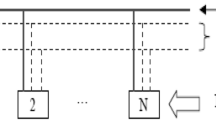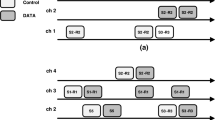Abstract
Using multiple channels in wireless networks improves spatial reuse and reduces collision probability and thus enhances network throughput. Designing a multi-channel MAC protocol is challenging because multi-channel-specific issues such as channel assignment, the multi-channel hidden terminal problem, and the missing receiver problem, must be solved. Most existing multi-channel MAC protocols suffer from either higher hardware cost or poor throughput. Some channel hopping multi-channel protocols achieve pretty good performance in certain situations but fail to adjust their channel hopping mechanisms according to varied traffic loads. In this paper, we propose a load-aware channel hopping MAC protocol (LACH) that solves all the multi-channel-specific problems mentioned above. LACH enables nodes to dynamically adjust their schedules based on their traffic loads. In addition to load awareness, LACH has several other attractive features: (1) Each node is equipped with a single half-duplex transceiver. (2) Each node’s initial hopping sequence is generated by its ID. Knowing the neighbor nodes’ IDs, a node can calculate its neighbors’ initial channel hopping sequences without control packet exchanges. (3) Nodes can be evenly distributed among available channels. Through performance analysis, simulations, and real system implementation, we verify that LACH is a promising protocol suitable for a network with time-varied traffic loads.















Similar content being viewed by others
References
Almotairi, K. H., & Shen, X. (2013). Multichannel medium access control for ad hoc wireless networks. Wireless Communications and Mobile Computing. 13(11), 1047–1059.
Hongjiang, L., Zhi, R., Chao, G., & Yongcai, G. (2012). A new multi-channel MAC protocol for 802.11-based wireless mesh networks. In IEEE ICCSEE (pp. 27–31).
Seo, M., Kim, Y., & Ma, J. (2008). Multi-channel MAC protocol for multi-hop wireless networks: Handling multi-channel hidden node problem using snooping. In Proceedings of IEEE MILCOM.
Wang, J., Fang, Y., & Wu, D. (2006). A power-saving multi-radio multi-channel MAC protocol for wireless local area networks. In Proceedings of IEEE INFOCOM (pp. 1–12).
Wu, S.-L., Tseng, Y.-C., Lin, C.-Y., & Sheu, J.-P. (2000). A new multi-channel MAC protocol with on-demand channel assignment for multi-hop mobile ad hoc networks. In Proceedings of IEEE ISPAN (pp. 232–237).
Almotairi, K. H., & Shen, X. (2011). Fast and slow hopping MAC protocol for single-hop ad hoc wireless networks. In IEEE ICC (pp. 1–5).
Kim, J.-H., & Yoo, S.-J. (2009). TMCMP: TDMA based multi-channel MAC protocol for improving channel efficiency in wireless ad hoc networks. In Proceedings of IEEE MICC (pp. 429–434).
Li, C.-Y., Jeng, A.-K., & Jan, R.-H. (2004). A MAC protocol for multi-channel multi-interface wireless mesh network using hybrid channel assignment scheme. Journal of Information Science and Engineering, 23, 1041–1055.
Pathmasuntharam, J. S., Das, A., & Gupta, A. K. (2004). Primary channel assignment based MAC (PCAM)—A multi-channel MAC protocol for multi-hop wireless networks. In Proceedings of IEEE WCNC (pp. 1110–1115).
Zhang, Z., Boukerche, A., & Ramadan, H. (2013). Design and evaluation of a fast MAC layer handoff management scheme for WiFi-based multichannel vehicular mesh networks. Journal of Network and Computer Applications, 36(3), 992–1000.
Khaled, H. A., & Xuemin, S. (2015). A distributed multi-channel MAC protocol for ad hoc wireless networks. IEEE Transactions on Mobile Computing, 14(1), 1–13.
Lin, T.-Y., Kun-Ru, W., & Yin, G.-C. (2015). Channel-hopping scheme and channel-diverse routing in static multi-radio multi-hop wireless networks. IEEE Transactions on Computers, 64(1), 71–86.
Incel, O. D., van Hoesel, L., Jansen, P., & Havinga, P. (2011). MC-LMAC: A multi-channel MAC protocol for wireless sensor networks. Ad Hoc Networks, 9, 73–94.
Ivanov, S., Botvich, D., & Balasubramaniam, S. (2012). Cooperative wireless sensor environments supporting body area networks. IEEE Transactions on Consumer Electronics, 58(2), 284–292.
Liao, W.-H., & Chung, W.-C. (2009). An efficient multi-channel MAC protocol for mobile ad hoc networks. In Proceedings of IEEE CMC (pp. 162–166).
Lin, C.-S., Wueng, M.-C., Chiu, T.-H., & Hwang, S.-I. (2007). Concurrent multi-channel transmission (CMCT) MAC protocol in wireless mobile ad hoc networks. In Proceedings of ICACT (pp. 445–449).
Luo, T., Motani, M., & Srinivasan, V. (2009). Cooperative asynchronous multichannel MAC design, analysis, and implementation. IEEE Transaction on Mobile Computing, 8(3), 338–352.
Shi, J., Salonidis, T., & Knightly, E. W. (2006). Starvation mitigation through multi-channel coordination. In Proceedings of ACM MobiHoc (pp. 214–225).
So, J., & Vaidya, N. (2004). Multi-channel MAC for ad hoc networks: Handling multi-channel hidden terminals using a single transceiver. In Proceedings of ACM MobiHoc (pp. 222–233).
Dang, D. N. M., Le, H. T., Kang, H. S., Hong, C. S., & Choe, J. (2015). Multi-channel MAC protocol with directional antennas in wireless ad hoc networks. In International conference on information networking (ICOIN) (pp. 81–86). IEEE.
Dang, D. N. M., Hong, C. S., & Lee, S. (2015). A hybrid multi-channel MAC protocol for wireless ad hoc networks. Wireless Networks, 21(2), 387–404.
Bahl, P., Chandra, R., & Dunagan, J. (2004). SSCH: Slotted seeded channel hopping for capacity improvement in IEEE 802.11 ad-hoc wireless networks. In Proceedings of ACM MobiCom (pp. 216–230).
Bian, K., Park, J.-M., & Chen, R. (2009) A quorum-based framework for establishing control channels in dynamic spectrum access networks. In Proceedings of ACM MobiCom.
So, H.-S. W., Walrand, J., & Mo, J. (2007). McMAC: A prarllel rendezvous multi-channel MAC protocol. In Proceedings of IEEE WCNC (pp. 334–339).
Chao, C.-M., Tsai, H.-C., & Huang, K.-J. (2014). A new channel hopping MAC protocol for mobile ad hoc networks. IEEE Transactions on Vehicular Technology, 63(9), 4464–4475.
Tang, L., Sun, Y., Gurewitz, O., & Johnson, D. B. (2011). EM-MAC: A dynamic multichannel energy-efficient MAC protocol for wireless sensor networks. In ACM MobiHoc.
Chao, C.-M., Tsai, H.-C., & Huang, C.-Y. (2012). Load-aware channel hopping protocol design for mobile ad hoc networks. In IEEE ISWPC (pp. 1–6).
Bao, L. (2004). MALS: Multiple access scheduling based on latin squares. In Proceedings of IEEE MILCOM (pp. 315–321).
Ju, J.-H., Victor, O., & Li, K. (1999). TDMA scheduling design of multihop packet radio networks based on latin squares. IEEE Journal on Selected Areas in Communications, 17, 1345–1352.
Park, M., & Kim, S.-L. (2008). Minimum distortion network code design for source coding over noisy channels. In Proceedings of IEEE PIMRC (pp. 1–5).
Oh, H.-Y., Kim, D.-S., Kim, J.-S. & Song, H.-Y. (2007). Collision-free Interleavers using Latin squares for parallel decoding of turbo codes. In Proceedings of IEEE VTC (pp. 1589–1592).
Sheu, J.-P., Chao, C.-M., Hu, W.-K., & Sun, C.-W. (2007). A clock synchronization algorithm for multihop wireless ad hoc networks. Wireless Personal Communications, 43(2), 185–200.
So, H.-S. W., Nguyen, G., & Walrand, J. (2006). Practical synchronization techniques for multi-channel MAC. In Proceedings of ACM MobiCom.
Acknowledgments
This research was sponsored by Ministry of Science and Technology, R. O. C., under grant NSC 102-2221-E-019-017-MY3.
Author information
Authors and Affiliations
Corresponding author
Rights and permissions
About this article
Cite this article
Chao, CM., Tsai, HC. & Huang, CY. Load-aware channel hopping protocol design for mobile ad hoc networks. Wireless Netw 23, 89–101 (2017). https://doi.org/10.1007/s11276-015-1139-1
Published:
Issue Date:
DOI: https://doi.org/10.1007/s11276-015-1139-1




